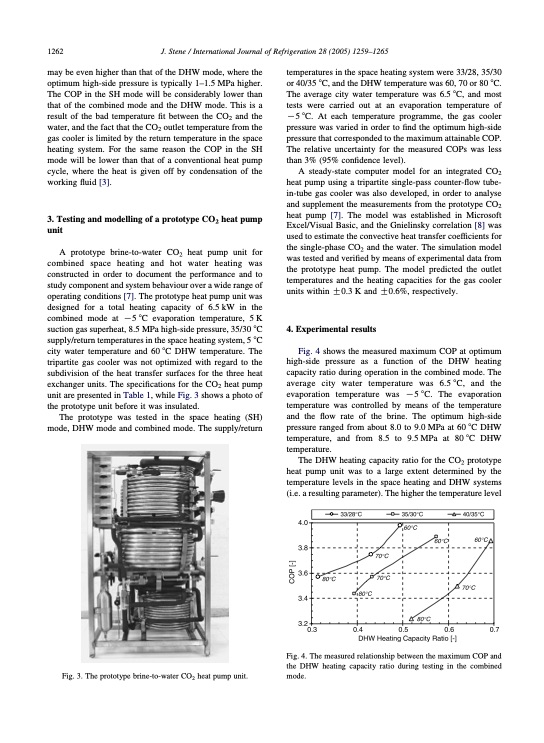
PDF Publication Title:
Text from PDF Page: 005
1262 J. Stene / International Journal of Refrigeration 28 (2005) 1259–1265 may be even higher than that of the DHW mode, where the optimum high-side pressure is typically 1–1.5 MPa higher. The COP in the SH mode will be considerably lower than that of the combined mode and the DHW mode. This is a result of the bad temperature fit between the CO2 and the water, and the fact that the CO2 outlet temperature from the gas cooler is limited by the return temperature in the space heating system. For the same reason the COP in the SH mode will be lower than that of a conventional heat pump cycle, where the heat is given off by condensation of the working fluid [3]. 3. Testing and modelling of a prototype CO2 heat pump unit A prototype brine-to-water CO2 heat pump unit for combined space heating and hot water heating was constructed in order to document the performance and to study component and system behaviour over a wide range of operating conditions [7]. The prototype heat pump unit was designed for a total heating capacity of 6.5 kW in the combined mode at K5 8C evaporation temperature, 5 K suction gas superheat, 8.5 MPa high-side pressure, 35/30 8C supply/return temperatures in the space heating system, 5 8C city water temperature and 60 8C DHW temperature. The tripartite gas cooler was not optimized with regard to the subdivision of the heat transfer surfaces for the three heat exchanger units. The specifications for the CO2 heat pump unit are presented in Table 1, while Fig. 3 shows a photo of the prototype unit before it was insulated. The prototype was tested in the space heating (SH) mode, DHW mode and combined mode. The supply/return Fig. 3. The prototype brine-to-water CO2 heat pump unit. temperatures in the space heating system were 33/28, 35/30 or 40/35 8C, and the DHW temperature was 60, 70 or 80 8C. The average city water temperature was 6.5 8C, and most tests were carried out at an evaporation temperature of K5 8C. At each temperature programme, the gas cooler pressure was varied in order to find the optimum high-side pressure that corresponded to the maximum attainable COP. The relative uncertainty for the measured COPs was less than 3% (95% confidence level). A steady-state computer model for an integrated CO2 heat pump using a tripartite single-pass counter-flow tube- in-tube gas cooler was also developed, in order to analyse and supplement the measurements from the prototype CO2 heat pump [7]. The model was established in Microsoft Excel/Visual Basic, and the Gnielinsky correlation [8] was used to estimate the convective heat transfer coefficients for the single-phase CO2 and the water. The simulation model was tested and verified by means of experimental data from the prototype heat pump. The model predicted the outlet temperatures and the heating capacities for the gas cooler units within G0.3 K and G0.6%, respectively. 4. Experimental results Fig. 4 shows the measured maximum COP at optimum high-side pressure as a function of the DHW heating capacity ratio during operation in the combined mode. The average city water temperature was 6.58C, and the evaporation temperature was K5 8C. The evaporation temperature was controlled by means of the temperature and the flow rate of the brine. The optimum high-side pressure ranged from about 8.0 to 9.0 MPa at 60 8C DHW temperature, and from 8.5 to 9.5MPa at 808C DHW temperature. The DHW heating capacity ratio for the CO2 prototype heat pump unit was to a large extent determined by the temperature levels in the space heating and DHW systems (i.e. a resulting parameter). The higher the temperature level Fig. 4. The measured relationship between the maximum COP and the DHW heating capacity ratio during testing in the combined mode.PDF Image | Residential CO2 heat pump system space and hot water heating

PDF Search Title:
Residential CO2 heat pump system space and hot water heatingOriginal File Name Searched:
Article_IIR-Journal_STENE_2005.pdfDIY PDF Search: Google It | Yahoo | Bing
CO2 Organic Rankine Cycle Experimenter Platform The supercritical CO2 phase change system is both a heat pump and organic rankine cycle which can be used for those purposes and as a supercritical extractor for advanced subcritical and supercritical extraction technology. Uses include producing nanoparticles, precious metal CO2 extraction, lithium battery recycling, and other applications... More Info
Heat Pumps CO2 ORC Heat Pump System Platform More Info
| CONTACT TEL: 608-238-6001 Email: greg@infinityturbine.com | RSS | AMP |